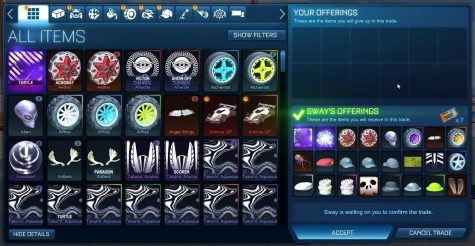The high-stakes trading game within Rocket League
January 28, 2021
Trading is a cutthroat business: you can grow extensively or fall to rock bottom. No, this isn’t a guide to playing the stock market– it’s a view into the obscured network of “commodity” trading found in the unlikeliest of places: the vehicular soccer video game Rocket League. Trading can be very hardcore in Rocket League; while the game allows users to trade cosmetic items such as hats, some of these items are highly coveted. One wrong trade and you can be out of a lot of money. Rocket League, developed by Psyonix Studios, has implemented a very complex trading system, and the community has become very involved in it. Although every online community has its bad side, Rocket League especially tends to have more toxic people and scammers.
While some rather play the standard game for the fun of it and ignore the trading aspect of Rocket League, or dabble in both playing and trading within the game, some users are dedicated solely to its lucrative trading market, which sees some in-game items selling as high as $12,000 US dollars. The basics of this trading system: items are obtained by simply playing matches of the standard game, and doing challenges to earn crates, which contain random assortments of these items. Each individual item in the game has a credit value, with credits serving as the main currency of the game. Users can either claw their way up by trading the lowest value items or buy credits with real money and start off strong. There are various websites that show prices for each item in game to help users figure out what their inventory is worth.

How does one trade? Well, for starters users have to invite someone to trade. To do this, they invite them to a lobby, click on their profile, and then click the “invite to trade” option. Then the other person has to agree, once they do, something similar to the image above should appear. On the left is the user’s inventory of owned items. If they click on one of the items, it will appear in the “your offerings” section. As for the other person’s inventory, they have to showcase their items by putting them up as an offer. Putting the items up is not permanent so users can take them down. Once both have agreed on a fair trade, both have to click “accept” and a five second countdown will start, if one person hits cancel the trade is called off.
While this process may seem secure, as with a lot of games that include trading, Rocket League has its fair share of scammers. Though there are many counters to scammers, it can still happen. A lot of times, it’s not the game’s fault, but the person just didn’t know the true worth of their items until they have already been scammed, and are just seeking another item they find cooler. Some scammers also find ways to exploit glitches in the game system by getting the items from the other person while not giving their own items. While most of these glitches are patched out quickly, they still get abused while they are out. The most popular of these types of scams is when at the last second of the countdown to confirm the trade they cancel, it doesn’t work now but people still try it.
In short, the Rocket League trading community is a complicated business. The massive network of trading and communication, and having to negotiate with people every trade while posting trades makes it a very time consuming thing. However, for some users, it’s worth the time and scams to acquire the more high end items that can go for a hundred dollars.



